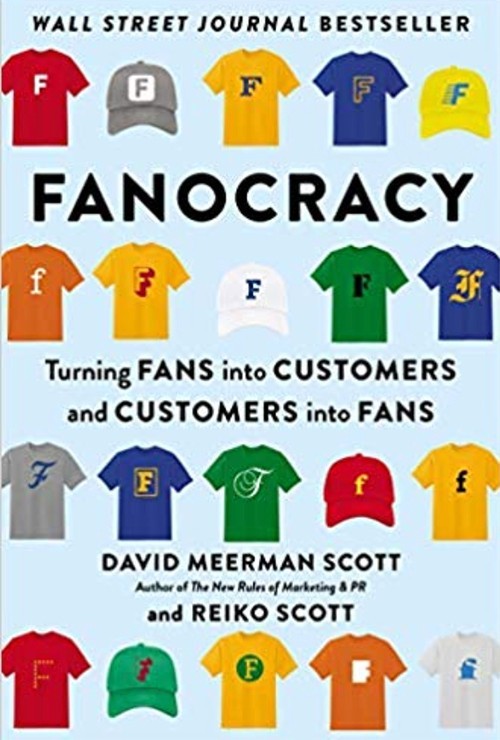Marketing Book Worth a Look: Fanocracy by David Meerman Scott and Reiko Scott
In the Internet Age, everything has been democratized, from influence to content creation to public relations. Brands no longer hold the cards, and the smart ones know it.
The pursuit of customers isn’t an adequate business model today according to David Meerman Scott, who believes that companies should be driven to foster fan communities by activating shared passions and establishing genuine human connections. He articulates the merits of this approach, and lays out a practical framework for putting it into action, in his latest book.
Take a Look: Fanocracy: Turning Fans into Customers and Customers into Fans, by David Meerman Scott and Reiko Scott
Many years have passed since David published the first edition of his bestselling book, The New Rules of Marketing and PR, back in 2007. By his own admission, much has changed since he laid out his vision for the evolving business landscape.
"It described the enormous and far-reaching power I saw with social media," David recounts in introducing his latest work. "That was back in the days when MySpace was more popular than Facebook, and Snapchat and Instagram didn't exist yet."
Over a decade-plus, the veteran marketer has watched that fledgling social landscape continue to blossom and expand, embedding itself as a fixture in our daily lives. This growth has been fueled in part by digital natives like his daughter Reiko, who co-authors Fanocracy.
“The idea for the book came about five years ago because when Reiko and I would get together or when we would communicate via email and text – frequently we would discuss fandom,” David explains on his blog, mentioning his personal affinity for The Grateful Dead, and Reiko’s love for the Harry Potter series. “We both agreed that fandom is not only a prescription for a more rewarding life for us, it’s also a way to do business!”
Finding Your Fandom
“A fanocracy is about the success that comes with developing passionate fans of your business,” David writes on the blog. “We learned that you are much more likely to build fans when you have a deep understanding of fandom culture yourself.”
The book explores this dynamic from many different perspectives, incorporating a wide array of examples from both business and pop culture. Within the pages of Fanocracy, you’ll draw marketing lessons from countless recognizable examples, such as:
- Subscription underpants company MeUndies demonstrating the power of fan-centric business.
- Starbucks showing how to get close to customers and drive connections between like-minded people.
- Backlash against the Star Wars franchise reflecting the investment that fandom can create.
- Air Jordans building an identity much greater than the shoes themselves.
- McKinsey & Company tapping its alumni as authentic influencers.
Naturally, there are also sections dedicated to The Grateful Dead and Harry Potter, because the authors had to let their own fandom shine through.
Fanocracy in the B2B Space
It’s interesting to think about the concept of fanocracy being applied in B2B. One might presume this approach is more pertinent for B2C brands, but there is ripe opportunity in business-oriented marketing where the lack of genuine connection, cited by David as an impetus for the movement, is especially pronounced.
His book includes a number of B2B examples, and brings to my mind plenty of others. For instance, there was the LinkedIn campaign from SolarWinds a few years back that struck a chord with an audience of IT professionals by giving away a multitool in the shape of Han Solo’s Millennium Falcon from Star Wars.
“People went bananas,” said SolarWinds’ Demand and Marketing Manager, Rebecca Smith. “Our engagement rate on LinkedIn for that campaign is probably the highest I’ve ever seen for any campaign that I’ve run across any platform.”
That type of connective energy, and the results it drove, serve to reinforce the premise of Fanocracy. As you read through the book, I recommend thinking deeply about your own audience members and how you might ignite their shared passions to strengthen the bond between company and customer.
“While many companies falsely think that their job is to facilitate a transaction and do so at as low a cost as possible, your job is to create fandom,” David writes in the book. “Your transition from transaction to fandom is especially powerful when you are dealing with stiff competition that offers products similar to yours. When others are simply selling products, you succeed by creating lasting relationships with those who will become lifelong fans. It requires a genuine interest in your customers, anticipating their needs and wants.”
Fanocracy: Turning Fans into Customers and Customers into Fans is available now and promises to be one of the most valuable reads for marketers in 2020. I’m definitely a fan.
Topics: Skill building and careers
Related articles






